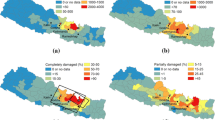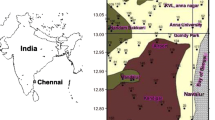Abstract
On October 30, 2020 14:51 (UTC), a moment magnitude (M) 7.0 (USGS, EMSC) earthquake occurred in the Aegean Sea. This paper presents the reconnaissance findings regarding the site effects on recorded strong ground motion intensities and duration, along with the resulting induced-structural damage in Izmir Bay and Samos Island, respectively. In all rock records, relatively high intensity long period rock spectral accelerations were observed in the mid to long period range of 0.5–1.5 s, which are attributed to the source, more specifically, to the slower rupture-mechanism of the event. These rich spectral intensities were further amplified by soil site effects and soil-superstructure resonance, leading to two to six times amplified overall responses and prolonged seismic shaking durations, more pronounced in Bayrakli and other Izmir Bay sites in Turkey. However, these amplified and prolonged excitations are still below design basis earthquake levels, which addresses the lack of proper structural design and construction deficiencies, as the underlying causes for the collapse to heavy damage performance of 795 buildings. On the other hand, although located only about 10 km from the rupture (22 km from the epicenter) and within the near fault zone, the town of Vathy on Samos Island (Greece) was rather lightly affected by the earthquake, with relatively few collapsed or heavily damaged buildings, partially attributed to the low height/low weight of structures in the area. However, a concentration of damage in low-rise buildings in Ano Vathy hill is considered indicative of a combination of coupled valley and topography effects on the strong motion. This event once again addressed the need to develop region-specific zonation and provisions, when more general code practices are proven to be inadequate to assess these extreme site effects.






























Similar content being viewed by others
References
Abrahamson N, Silva WJ, Kamai R (2014) Summary of the ASK14 Ground Motion Relation for Active Crustal Regions. Earthq Spectra 30(3):1025–1055. https://doi.org/10.1193/070913EQS198M
Akbuga E (2019) Seferihisar (Izmir) Bolgesinde Sivilasma Analizi ve Haritalandirilmasi. Manisa Celal Bayar Üniversitesi, Master Thesis (in Turkish)
Boore DM, Stewart JP, Seyhan E, Atkinson GM (2014) NGA-West2 equations for predicting PGA, PGV, and 5% damped PSA for shallow crustal earthquakes. Earthq Spectra 30:1057–1085
Bouckovalas GD, Papadimitriou AG (2005) Numerical evaluation of slope topography effects on seismic ground motion. Soil Dyn Earthq Eng 25(7–10):547–555
Building Seismic Safety Council (BSSC) (2020) NEHRP Recommended Seismic Provisions for New Buildings and Other Structures, FEMA P-2082–1, Washington, DC, pp 593. https://www.fema.gov/sites/default/files/2020-10/fema_2020-nehrp-provisions_part-1-and-part-2.pdf
Campbell KW, Bozorgnia Y (2014) NGA-West2 ground motion model for the average horizontal components of PGA, PGV, and 5% damped linear acceleration response spectra. Earthq Spectra 30:1087–1115
Cetin KO, Altun S, Askan A, Akgün M, Sezer A, Kıncal C, Ozdag OC, Ipek Y, Unutmaz B, Gulerce Z, Ozacar AA, Ilgaç M, Can G, Cakir E, Söylemez B, El-Sayeed A, Zarzour M, Bozyiğit I, Tuna C, Köksal D, Karimzadeh S, Uzel B, Karaali E (2021) The site effects in Izmir Bay of October 30 2020, M7.0 Samos Earthquake. Soil Dyn Earthq Eng (under review)
Chiou BSJ, Youngs RR (2014) Update of the Chiou and Youngs NGA model for the average horizontal component of peak ground motion and response spectra. Earthq Spectra 517(30):1117–1153
EN 1998-1 (2004) Eurocode 8: design of structures for earthquake resistance. 1st ed, Brussels, BSi
Erdoğan B (1990) Stratigraphy and tectonic evolution of İzmir-Ankara zone between İzmir and Seferihisar. TAPG Bull 2(1):1–20 ((in Turkish))
Gulerce Z, Akbaş B, Özacar AA, Sopacı E, Önder FM, Uzel B, Can G, Cakir E, Ilgaç M, Söylemez B, Saltoğlu N, Askan A, Cetin KO, Unutmaz B. (2021) Predictive performance of current ground motion models for recorded strong motions in 2020 Samos Earthquake. Soil Dyn Earthq Eng (under review)
HSGME (Hellenic Survey of Geology and Mineral Exploration) (1979) Geological Map of Samos Island (Scale 1:50,000).
ITSAK- EPPO (2020) The Earthquake of Oct. 30, 2020, Mw7.0 (11:51GMT) North of Samos Island (Greece): Observed strong ground motion on Samos island, -Preliminary Report ITSAK v3.0, Thessaloniki p 9
Kalogeras I, Melis NS, Kalligeris N (2020) The earthquake of October 30th, 2020, at Samos, Eastern Aegean Sea, Greece. Preliminary Report v2., National Observatory of Athens, Institute of Geodynamics, Greece
Kıncal C (2005) Engineering geological evaluation of geological units outcrop in and around the Izmir city centre with the help of geographical information systems and remote sensing techniques, Dokuz Eylul University, The Graduate School of Natural and Applied Sciences, PhD thesis, p 342, Izmir (in Turkish).
Koca, M. Y. (1995) Slope stability assessment of the abandoned andesite quarries in and around the Izmir city centre. Unpublished Ph.D. thesis, Dokuz Eylul University, Izmir, p 430
Kubilay K (2012) Deprem Dalgalarinin Zemin Büyütmesi Üzerine Örnekler. TÜBAV Bilim Dergisi 5(4):17–32
Margaris V, Papaioannou C, Theodoulidis N, Savvaidis A, Klimis N, Makra K, Karakostas C, Lekidis V, Makarios T, Salonikios T, Demosthenus M, Athanasopoulos G, Mylonakis G, Papantonopoulos C, Efthymiadou V, Kloukinas P, Ordonez I, Vlachakis V, and Stewart JP (2008) Preliminary report on the principal seismological and engineering aspects of the Mw = 6.5 Achaia-Ilia (Greece) earthquake on 8 June 2008. GEER Association Report No. GEER-013, Web report
Mayoral J, Asimaki D, Tepalcapa S, Wood C, Roman-de la Sancha A, Hutchinson T et al (2019) Site effects in Mexico City basin: Past and present. Soil Dyn Earthq Eng 121:369–382. https://doi.org/10.1016/j.soildyn.2019.02.028
Nikolaou et al (2014) Geotechnical Aspects of the M = 6.1 January 27 and February 03, 2014, Cephalonia, Greece, Earthquakes. GEER Association Report No. GEER-034 Web report
Pamuk E, Akgün M, Özdağ Ö, Gönenç T (2017) 2D soil and engineering-seismic bed-rock modeling of eastern part of Izmir inner bay/Turkey. J Appl Geophys 137:104–117. https://doi.org/10.1016/j.jappgeo.2016.12.016
Pamuk E, Gönenç T, Özdağ ÖC et al (2018a) 3D Bedrock Structure of Bornova Plain and Its surroundings (İzmir/Western Turkey). Pure Appl Geophys 175:325–340. https://doi.org/10.1007/s00024-017-1681-0
Pamuk E, Özdağ ÖC, Akgün M (2018b) Soil characterization of Bornova Plain (Izmir, Turkey) and its surroundings using a combined survey of MASW and ReMi methods and Nakamura’s (HVSR) technique. Bull Eng Geol Environ 78:3023–3035. https://doi.org/10.1007/s10064-018-1293-7
Pamuk E, Özdağ ÖC, Akgün M (2019) Soil characterization of Bornova Plain (Izmir, Turkey) and its surroundings using a combined survey of MASW and ReMi methods and Nakamura’s (HVSR) technique. Bull Eng Geol Env 78(4):3023–3035
Papadimitriou AG (2019) An engineering perspective on topography and valley effects on seismic ground motion. Theme Lecture, 7th International Conference on Earthquake Geotechnical Engineering, June 16–19, Rome, Italy
Papadimitriou AG, Paraskevopoulos SA, and Lamprakopoulos AN (2018) Aggravation of spectral acceleration along 2D symmetrical trapezoidal valleys. Proceedings, 16th European Conference on Earthquake Engineering, Thessaloniki, Greece, Paper ID: 11491
Roche V, Jolivet L, Papanikolaou D, Bozkurtf E, Menant A, Rimmelé G (2019) Slab fragmentation beneath the Aegean/Anatolia transition zone: Insights from the tectonic and metamorphic evolution of the Eastern Aegean region. Tectonophysics 754:101–129
Rollins KM, Singh M, Roy J (2020) Simplified Equations for Shear-Modulus Degradation and Damping of Gravels. J Geotech Geoenviron Eng 146(9):1. https://doi.org/10.1061/(ASCE)GT.1943/5606.0002300
Schnabel PB (1973) Effects of local geology and distance from source on earthquake ground motions. PhD Thesis, University of California, Berkeley, California
Seed HB, Idriss IM (1970) Soil moduli and damping factors for dynamic analysis. EERC Report No. 10–70, University of California
Stewart JP, Klimis N, Savvaidis A, Theodoulidis N, Zargli E, Athanasopoulos G, Pelekis P, Mylonakis G, Margaris B (2014) Compilation of a local vs profile database and its application for inference of VS30 from geologic- and terrain-based proxies. Bull Seism Soc Am 104(6):2827–2841
TEC (2018). Turkish Earthquake Code: Specifications for Building Design Under Earthquake Effects
Vessia G, Russo S, Lo Presti D (2011) A new proposal for the evaluation of the amplification coefficient due to valley effects in the simplified local seismic response analyses. Rivista Italiana Di Geotecnica 4:51–77
Vucetic M, Dobry R (1991) Effect of Soil Plasticity on Cyclic Response. J Geotech Eng 117:89–107
Yakut A, Binici B, Ilki A, Canbay E, Donmez C (2021) Observations, Damage distribution and Performance of Buildings in İzmir after the Samos Island Earthquake. Bull Earthq Eng (under review)
Acknowledgements
The authors are indebted to Professor George Bouckovalas of the National Technical University of Athens, Prof. Dr. Atilla Ansal of Ozyegin University, Istanbul, Prof. Dr. Ayfer Erkin of Istanbul Technical University, Prof. Dr. Bilge Siyahi of Gebze Technical University, Istanbul for their valuable review of the paper, and their insightful comments that significantly improved many of the discussions presented herein, particularly those pertaining to site effects in the town of Vathy and city Izmir. The authors would also like to deeply thank external contributors who kindly provided data and assistance with carrying out field measurements included in this paper. In this regard, George Milionis, Geologist, provided the boreholes log data for BH1, BH2, BH3 and BH4 shown in Fig. 20 and Fig. 24, while the borehole log data for BH5 shown in Fig. 20 was provided by Peggy Sechioti, employee of the Greek Ministry of Infrastructure and Transport. A number of photographs and information about structural damage in Ano Vathy were provided by HAEE/ETAM members Christos Giarlelis and Prof. A. Sextos, respectively. Information about the orientation and polarity of the strong motion instruments at Vathy was provided by Drs Ioannis Kalogeras, Vassilis Margaris and Nikos Theodulidis of NOA and ITSAK-EPPO. MASW and HVSR field measurements by Prof. P. Pelekis were supported by Vasilis Christopoulos, laboratory member, and Paraskevi Paliatsa, postgraduate student, of the Civil Engineering Department, University of Patras. Additionally, a number of photographs and information about structural damage in Izmir Bayrakli were provided by Ali Aksoyer. Their valuable contribution is gratefully acknowledged. The members of Middle East Technical University, Ankara, were partially funded by reconnaissance funds of METU, which is greatly appreciated. Financial support to the U-Patras team was provided by HAEE/ETAM. Prof Katerina Ziotopoulou’s field reconnaissance and participation was supported by the NSF-sponsored Geotechnical Extreme Events Reconnaissance (GEER) association. The work of the GEER Association, in general, is based upon work supported in part by the National Science Foundation through the Geotechnical Engineering Program under Grant No. CMMI-1826118. Any opinions, findings, and conclusions or recommendations expressed in this material are those of the authors and do not necessarily reflect the views of the NSF. Any use of trade, firm, or product names is for descriptive purposes only and does not imply endorsement by the U.S. Government. The GEER Association is made possible by the vision and support of the NSF Geotechnical Engineering Program Directors: Dr. Richard Fragaszy and the late Dr. Cliff Astill. GEER members also donate their time, talent, and resources to collect time-sensitive field observations of the effects of extreme events. Last but not least, thanks to EduPro Civil Systems Inc., the ProShake software license was freely provided for assessing site response analyses, which is acknowledged.
Author information
Authors and Affiliations
Corresponding author
Additional information
Publisher's Note
Springer Nature remains neutral with regard to jurisdictional claims in published maps and institutional affiliations.
Rights and permissions
About this article
Cite this article
Cetin, K.O., Papadimitriou, A.G., Altun, S. et al. The role of site effects on elevated seismic demands and corollary structural damage during the October 30, 2020, M7.0 Samos Island (Aegean Sea) Earthquake. Bull Earthquake Eng 20, 7763–7792 (2022). https://doi.org/10.1007/s10518-021-01265-z
Received:
Accepted:
Published:
Issue Date:
DOI: https://doi.org/10.1007/s10518-021-01265-z




